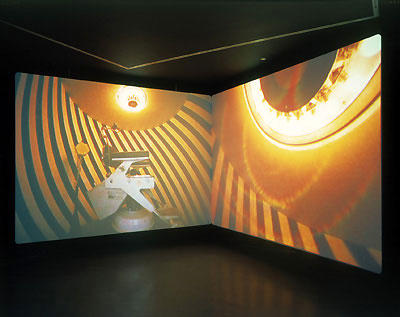
Earlier this year at the Gagosain gallery in London, there was a rather dissonant exhibition, Crash, of artworks notionally inspired or reflective of the work of JG Ballard. A highlight for me was the installation 'Proton, Unity, Energy, Blizzard' by Jane and Louise Wilson, which induced an attack of hyperkulturemia.
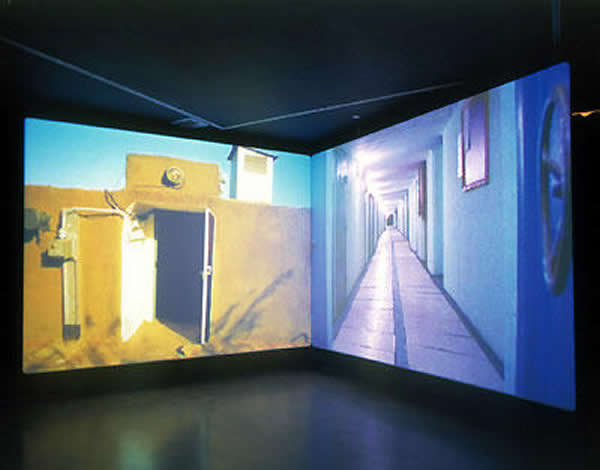
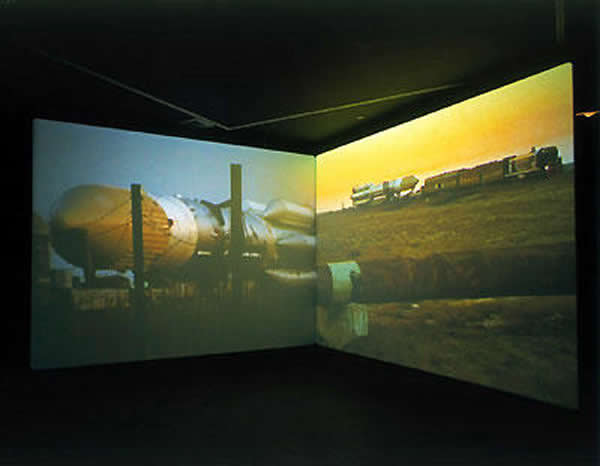
The installation, first shown in 2001, consists of 2 double video screens, mounted in opposite corners of a darkened space, so that they faced each other across a rectangular space. Footage from the Soviet space program, of the Blizzard1 shuttle craft ('Buran'), the Energy ('Energia') rocket module, the Proton rocket, and the Unity rocket ('Soyuz'), gives the installation its title. The camera dollies slowly across the exterior length of the enormous rockets, both inside the assembly facility and also on the launch site at Baikonur.
As obsessed as I am with the dream of the Soviet space programme, the architectonic qualities of launch towers, Constructivist visions made solid, a technological will to power made manifest, this was an unexpected sight, which totally caught me by surprise. I stood transfixed in the middle of the room slowly twisting from screen to screen.
Slowly it becomes apparent that the facing screens are not simply showing identical footage. Sometimes the footage is slightly out of sync, or taken from a slightly different angle, at other times the direction of panning is reversed on one screen pair. The effect of this, and also the fact that the space is not square - they screens do face each other directly - creates a very unsettling experience. For me, the presentation and the subject matter created such a overwhelming experience that I felt myself becoming dizzy, my knees starting to wobble. This was the strongest visceral reaction to a piece of art that I have ever felt, a form of Stendhal Syndrome.
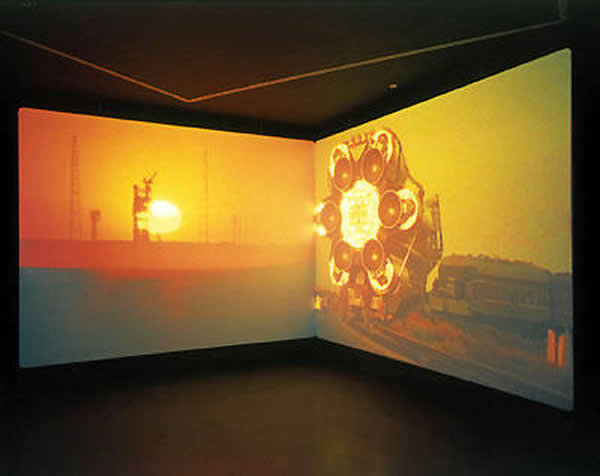
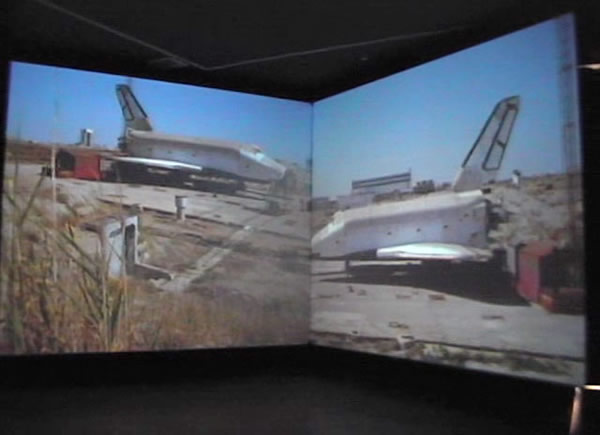
This is what Space Place had to say:
"The installation Proton, Unity, Energy, Blizzard is a pure exploration of architecture. Proton, Unity, Energy, Blizzard, shows the Cosmodrome of Baikonur in the south of Kazakstan. It was from Baikonur that in 1961 Yuri Gagarin became the first man to be launched into space. The title of the work refers to the three launch sites that appear in the film. Proton, a military site, Unity (Soyuz), the site for manned missions to space, and Energy (Energiya), which was designed to carry the Russian space shuttle Blizzard (Buran). The opening shots show the launch site of Energy and Blizzard, now abandoned for over ten years. The film then changes to the operational Proton launch site. The sequence, which includes interior shots of the assembly factory, culminates in the transport of a Proton rocket to the launch site at dawn. After a series of pictures from Korkytu-ata, a Muslim memorial site of comparative architectural significance near Baikonur, the film returns to the launch sites of Unity, which remains almost unchanged since the times of Gagarin, and Proton, with its vast arms reaching out into the desert. In the final sequence, with the Energia/Buran site in the distance and camels grazing in the foreground, it seems as if the desert is reclaiming its land."
Proton, Unity, Energy, Blizzard is a companion to an earlier piece by the Wilson sisters. Star City , which uses the same 4-screen device, described here:
"Viewers are caught up between juxtaposed shots of the same scene and images sliding across the four screens of the installation as the camera pans across the rooms and their contents. Feelings of discomfort and paranoia develop as the viewers positioned in the open cube of the screens are forced to be “on constant alert … lest they miss something”(12). The endless loops of the roller coaster mystery tour through Star City create a 'sense of going somewhere and nowhere at once'"
Elsewhere, the Wilson's work is described thus:
"Like Leni Riefenstahl, the British twins Jane and Louise Wilson create works that estheticize power, but to obviously different ends. Unlike Hitler's favorite filmmaker, their film installations are more funereal than triumphant.
For their newest odes to eroded power and faded glory, a pair of videos called Star City and Proton, Unity, Energy, Blizzard, the Wilsons were granted access to high-security sites of the financially stricken and scaled-back Russian space program. The videos were shot, respectively, at Star City, the main training center for Russian cosmonauts just outside Moscow, and the Baikonur cosmodrome, the massive base of the space program located in modern-day Kazakhstan (though the program is still operated by Russia). These sites, once beacons of Soviet power, are now in such a state of decline that it is sometimes difficult to tell which facilities are still in use and which are abandoned. This sense of desolation is heightened by the near-total absence of people in their footage."
Quite what all this had to do with JG Ballard I'm not sure, except some forlorn sense of humans not being entirely in control of the technologies they create, and that visions of the future are often crushed by the realities of the present. Baikonur, the original Kosmograd, represents the genius-loci of lost future dreams, one of the most mythically charged places on the Earth.
- 'Buran' is more often translated as 'Snowstorm' but here the Wilson twins have chosen to interpret it as 'Blizzard'. In the book Energiya-Buran by Bart Hendrickx and Bert Vis it is more precisely defined a a snowstorm that is unique to the steppes of Kazakhstan.
↩
